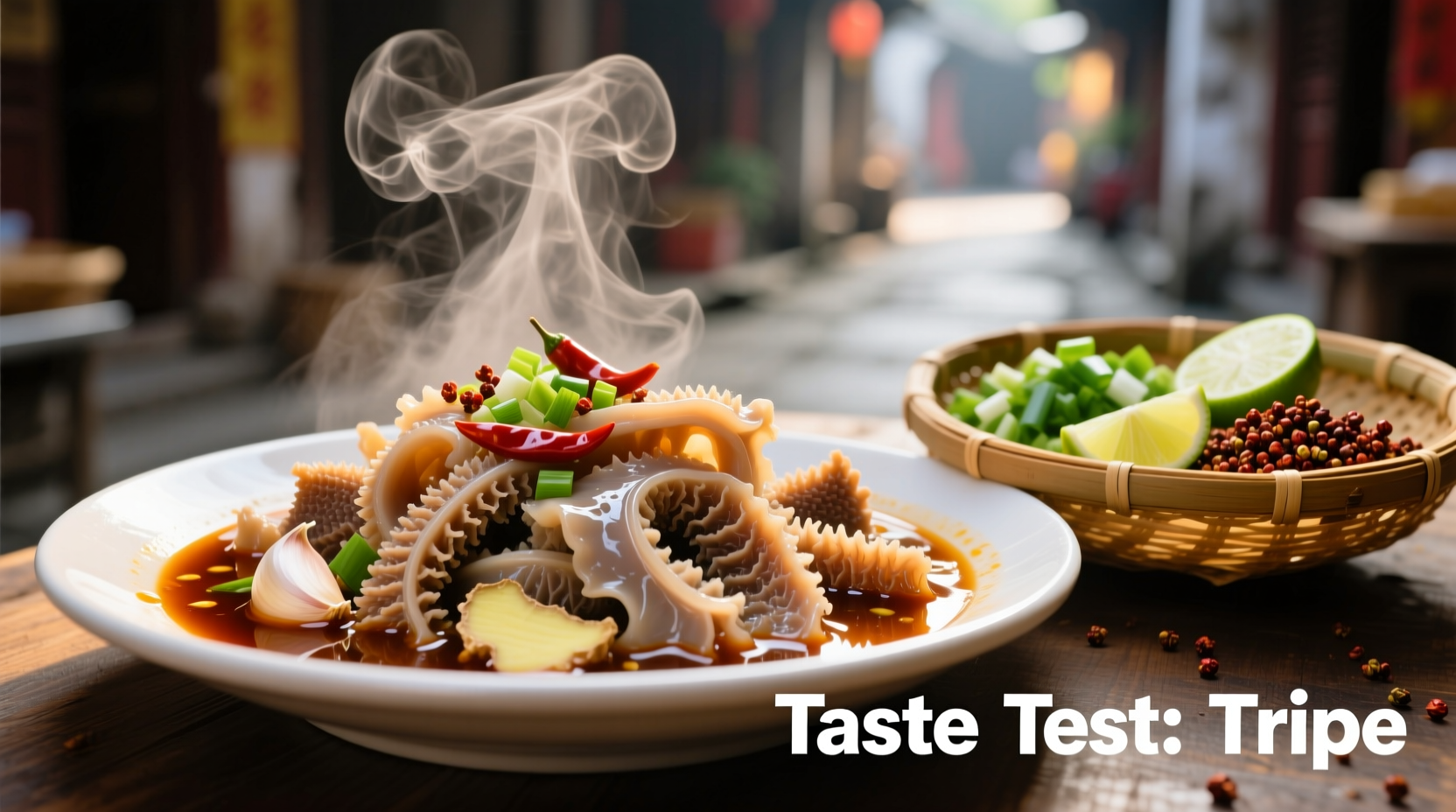Understanding Tripe's Flavor Profile: Beyond the Myths
Many people approach tripe with hesitation, expecting an overpowering flavor. The truth? fresh, properly cleaned tripe tastes remarkably neutral—more like a culinary canvas than a dominant ingredient. This mildness explains why cultures worldwide incorporate it into complex broths and stews where it absorbs surrounding flavors while contributing unique textural contrast.
What Does Tripe Actually Taste Like? A Sensory Breakdown
When prepared correctly, tripe offers a surprisingly delicate eating experience. Let's examine each sensory dimension:
Taste Characteristics
Tripe itself has minimal inherent flavor—think of it as nature's blank slate. High-quality, well-prepared tripe delivers:
- Mild sweetness from natural glycogen stores
- Subtle earthiness reminiscent of mushrooms
- Neutral base that readily absorbs broth flavors
- No gamey aftertaste when properly cleaned
Texture Transformation Through Cooking
The texture experience defines tripe more than its flavor. Understanding this progression is crucial for first-time tasters:
| Cooking Stage | Texture Description | Flavor Absorption |
|---|---|---|
| Raw (uncleaned) | Firm, rubbery | Minimal (requires cleaning) |
| After Cleaning | Soft, slightly spongy | Beginning to absorb flavors |
| 2-3 Hours Simmering | Tender-chewy, meaty bite | Moderate absorption |
| 4+ Hours Simmering | Melt-in-mouth, gelatinous | Full flavor integration |
This texture evolution explains why tripe preparation time dramatically affects the eating experience. Undercooked tripe becomes unpleasantly chewy, while properly simmered tripe achieves that prized tender-yet-substantial bite that defines dishes like Mexican menudo and Italian trippa alla romana.

Why Preparation Method Changes Everything
The common misconception that "tripe tastes bad" usually stems from improper preparation. Consider this culinary timeline showing how technique affects flavor:
| Era | Preparation Method | Resulting Flavor Profile |
|---|---|---|
| Ancient Times | Rapid boiling without cleaning | Strong, unpleasant odor and taste |
| Medieval Europe | Vinegar soaking before cooking | Reduced but still noticeable off-flavors |
| Modern Technique | Multi-stage cleaning + 4+ hour simmering | Neutral base absorbing surrounding flavors |
Today's professional kitchens follow a meticulous process: thorough scrubbing, vinegar or lemon juice baths, multiple water changes, and extended simmering with aromatics. This transforms tripe from potentially off-putting to delicately textured and flavor-absorbent.
Regional Variations: How Culture Shapes Tripe's Flavor
Tripe's neutral flavor profile makes it the perfect vehicle for regional spice traditions. What does tripe taste like in different culinary contexts?
Mexican Menudo
In this beloved hangover remedy, honeycomb tripe simmers for hours in a rich broth with guajillo chilies, oregano, and garlic. The tripe absorbs the complex chili flavors while maintaining its signature chew, creating what many describe as "a comforting, slightly spicy warmth with substantial texture".
French Andouille
French chefs prepare tripe with white wine, shallots, and tarragon, resulting in a delicate dish where the tripe's mild sweetness complements the herbal notes. Properly executed, it should taste "like a refined stew where the tripe provides satisfying texture without overpowering the subtle broth".
Chinese Beef Tripe
In Cantonese cuisine, blanched tripe appears in cold dishes with ginger-scallion oil or in hot pots. The quick cooking preserves more texture while allowing the tripe to carry the aromatic oil flavors. Diners often describe it as "crisp-tender with a clean finish that highlights the accompanying sauces".
First-Time Taster's Guide: What to Expect
If you're wondering "does tripe taste good to beginners?", consider these practical insights:
Setting Realistic Expectations
Well-prepared tripe should never taste:
- Strongly of ammonia (indicates improper cleaning)
- Overpoweringly "offal-like" (suggests undercooking)
- Fishy or sour (sign of spoilage)
Instead, expect:
- A texture somewhere between calamari and slow-cooked pork belly
- A flavor profile dominated by the surrounding broth or sauce
- A satisfying chew that becomes tender with proper cooking
Tips for the Best First Experience
Maximize your chances of enjoying tripe with these professional recommendations:
- Start with regional specialties like menudo or French tripes à la mode where preparation methods are perfected
- Avoid rubbery textures by ensuring tripe has simmered at least 3-4 hours
- Pair with bold flavors that complement rather than mask the texture
- Choose honeycomb tripe for the most approachable texture
Debunking Common Tripe Myths
Let's address frequent misconceptions that deter potential tasters:
"Tripe tastes strongly of stomach"
This stems from improper cleaning. When processed correctly following USDA food safety guidelines, tripe loses any stomach-like characteristics. The USDA confirms that thorough cleaning and cooking eliminate unwanted flavors.
"All tripe is chewy and unpleasant"
Texture depends entirely on cooking time and method. Undercooked tripe remains rubbery, but properly simmered tripe achieves that prized tender-yet-substantial bite that defines quality preparations.
"You can't taste anything but the texture"
While texture is prominent, tripe readily absorbs surrounding flavors. In traditional menudo, it carries the complex chili notes; in French preparations, it takes on wine and herb characteristics.
How to Evaluate Quality Tripe
Knowing what good tripe should taste like helps avoid disappointing experiences. Use this evaluation framework:
| Quality Indicator | Acceptable | Problematic |
|---|---|---|
| Smell | Neutral or broth-like | Ammonia or sour notes |
| Taste | Mild, absorbing surrounding flavors | Strongly unpleasant aftertaste |
| Texture | Tender-chewy to melt-in-mouth | Rubbery or mushy |
This evaluation method, recommended by culinary institutes like the Culinary Institute of America, helps distinguish properly prepared tripe from substandard versions.
Final Thoughts: Embracing Tripe's Culinary Potential
When prepared with care, tripe offers a uniquely satisfying eating experience that has endured across cultures for centuries. Its mild flavor and transformative texture make it a culinary chameleon—equally at home in spicy Mexican stews, delicate French preparations, or aromatic Asian broths. Understanding what tripe tastes like—and how preparation affects that experience—opens the door to appreciating this traditional ingredient beyond the misconceptions.











 浙公网安备
33010002000092号
浙公网安备
33010002000092号 浙B2-20120091-4
浙B2-20120091-4